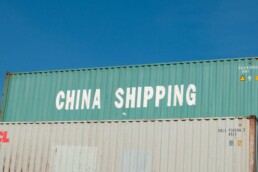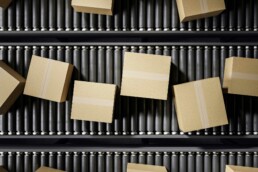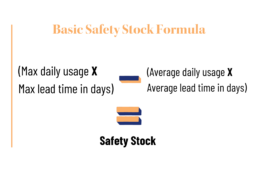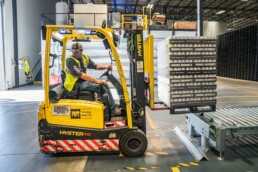5 Habits of Successful E-commerce Businesses
Habits of Successful E-commerce Businesses
E-commerce is snowballing, with more than 9.1 million global online stores. In this landscape, the most successful businesses focus on and implement similar strategies. While this list isn’t exhaustive, these habits of successful e-commerce businesses strategies are common among some of the most profitable online companies. To make your business stand out, modeling the practices of successful e-commerce businesses is necessary. In this post, we will discuss 5 habits of successful e-commerce businesses.

Automation
To implement automation strategies for e-commerce success, consider how automation can improve customer experience. This involves automating customer service inquiries, setting up automated reminders to encourage repeat purchases, or sending automated emails to provide order updates. Now, let’s explore some of the most common marketing automation strategies:
- Sending automated welcome emails
- Automated cart recovery (abandoned cart reminders)
- Win-Back emails to get subscribers re-engaged
- Automate customer feedback collection
Look for opportunities to automate inventory management, shipping processes, and product discovery. Automation of these processes can help streamline operations and improve customer experience. Additionally, use analytics to track success of automation strategies and adjust accordingly.

Collaborate and Outsource
It is common for e-commerce owners to get nervous about collaborations. However, they believe that if they drive traffic to other companies, customers won’t have enough resources left to buy their products. While driving traffic to your direct competitor might do that, other symbiotic collaborations have the opposite effect. An excellent example of an ideal collaboration is Black Milk Clothing and Solestruck. Black Milk Clothing sells clothes for people who want to stand out. Their fashion line nods to niche horror films, Pokemon, and other cult-classic imagery. In a successful collaboration, they teamed up with Solestruck, a funky female-owned shoe company, on a few photo shoots, and people started asking where they could buy the shoes. This collaboration was a win-win for both brands. The key is to find mutually beneficial collaborations. To get you started, here are some easy collaboration ideas:
- Cross promotions
- Social media giveaways and influencer campaigns
- Subscription boxes with multiple partners
- Creating (topic clusters) with other retailers in similar or complementary industries
The other aspect that rings of collaboration is outsourcing business operations that are not part of the core offering to other professionals. By delegating these responsibilities to experts in that field, you free up time to focus on core competencies of the business, such as creating new products, refining customer offerings, and building marketing campaigns that singularly target your customer avatar. Now, let’s delve into the types of outsourcing that the most successful entrepreneurs engage in:
- Social media management
- Website design and development
- Warehousing
- Inventory Management
- Order fulfillment
- Customer service
- Returns management

Track and Utilize Data Analytics
You must track the data. Regardless of whether you sell hand-poured candles or reusable baby diapers, data is crucial for making informed decisions. Successful e-commerce businesses have a habit of monitoring data and utilizing it effectively to refine their business processes. Nevertheless, it can be daunting to consider all the data points vital to business success. To help with this, here are some of the top metrics that e-commerce businesses should track:
- Customer Acquisition Cost – Simply put, this is the amount of capital it costs to acquire a new customer
- Average Order Value – This is the average amount customers are spending at one time in your store
- Sales Conversion Rate – This is the number of customers who made a purchase compared to the total visitors to your store

Other Metrics To Measure
- Shopping Cart Abandonment Rate – This evaluates the number of customers who add a product to their cart but fail to complete the purchase. Tracking this metric can provide insight into troubles or difficulties with the purchasing process.
- Top Products Sold – Tracking the most popular products is essential to profitability. Best sellers should be promoted and carefully ordered to minimize stockouts.
- Return Rates – This calculates how many products sold are being returned or exchanged.
- Regular Inventory Snapshots – Tracking how much inventory you have left at the end of a specific period helps you develop a cadence of reordering to limit overstocking and understocking.
There are so many more metrics that can be tracked and evaluated. However, it’s essential to recognize that data fatigue is a real issue for many owners. Instead of getting overwhelmed by all the available reports, narrow down what is vital for your business. Decide on the information you currently need to make better decisions. Focus on tracking and utilizing those metrics first, and then, you can gradually expand your usage of data and analytics.

Focus on Customer Experience
According to Forbes, “Customer experience is today’s business benchmark.” In this ever-evolving landscape, it’s crucial to prioritize your customers. They now demand more than just a transactional relationship with a brand; they seek a complete experience. This encompasses everything from memorable unboxing experiences to hassle-free return policies. Successful e-commerce businesses continually evaluate and enhance the customer experience. Here are the key aspects to consider:
- Seamless user experience on your website – This implies that your website should be user-friendly, with fast loading speeds and visually appealing design. Remember, investing in high-quality product photos is worth far more than a thousand words – it’s worth a thousand dollars!
- Secure and varied payment methods – Offering multiple secure payment options enhances customer satisfaction.
- Excellent customer service – Gone are the days when part-time customer support sufficed. To stand out in a competitive market, you must be ready to assist your customers when they need it. While around-the-clock call center support may not be necessary, having systems like chatbots and FAQs readily available is a must from the moment you make your first sale.
- Implement Customer Loyalty Programs – Rewarding customers for their purchases and encouraging them to return is easily achieved through customer loyalty programs.
- Provide Seamless Omnichannel Experience – Customers now expect brand consistency across every platform. Ensuring a seamless omnichannel experience not only fosters brand loyalty but also builds trust in your company.

Experiment and Test
One of the most vital habits of successful e-commerce businesses is they are not afraid to experiment and test new things. Innovation in any industry comes from trial and error. Here are some common forms of business experimentation:
- A/B Testing – Testing two versions of the same material
- Pilot – A trial that would help test a proof of concept to see if you should go further with it
- Mockups – A representation of the look and feel of a user interface
- Quantification – Asking an audience to rank and rate things to quantify their thoughts into data
Beginner’s Guide to Third-Party Logistics (3PL)
The world of e-commerce is always changing, therefore understanding the roll of Third-Party Logistics is integral to keeping up. In light of this our beginner’s guide to third-party logistics (3PL) will delve into the essential aspects, offering insights into fulfillment services, warehousing, and much more.
Read More…
These experiments can be applied to marketing strategies, new product development, and even improving the customer experience online. Regardless of what experiments you run, it is important to decide what question you are trying to answer so that you can build an effective test. In other words, you need to think like a business person and a scientist.
The 5 habits of successful e-commerce businesses aren’t rocket science but require focused attention. Companies prioritizing automation, collaboration, outsourcing, tracking data, experimentation, and being customer obsessed stand a higher chance of success. Did you know that Falcon Fulfillment can help with many of these habits? We are experts at order fulfillment, warehousing, inventory management, returns management, customer service, and more. Let us show you how partnering with us can lead to better outcomes and more freedom to focus on what matters most, your customers! Talk to one of our helpful agents today.
Contact us to learn more about our services.
Let’s Talk!
Small Business E-commerce Growth: Navigating Headwinds
Navigating Headwinds and Seizing Opportunities – Small Business E-commerce Growth
The business landscape is evolving rapidly, presenting small businesses with unique challenges and opportunities. Economic headwinds persist, yet the potential for small business e-commerce growth shines brightly. Let’s delve into the current state of small business e-commerce, examining the obstacles they face and the strategies they’re employing to thrive in an increasingly digital marketplace.

E-commerce: A Lifeline for Small Businesses
Despite economic uncertainties, small businesses are increasingly embracing e-commerce as a vital growth channel. The shift towards online shopping, accelerated by recent global events, has created new avenues for expansion. Many small business owners now recognize the potential of e-commerce fulfillment to broaden their customer base and boost sales.
However, capitalizing on this small business e-commerce growth isn’t without its hurdles. From mastering order fulfillment solutions to navigating the complexities of shipping and delivery, small businesses must adapt swiftly to remain competitive. Fortunately, a variety of tools and services are available to support their success in the digital marketplace.

Navigating the Headwinds
Small businesses must contend with several significant challenges:
- Economic Volatility: Inflation and fluctuating consumer spending patterns create an unpredictable business environment.
- Supply Chain Disruptions: Global events continue to impact supply chain management, affecting inventory and delivery times.
- Increased Competition: As more businesses move online, standing out in a crowded marketplace becomes increasingly difficult.
- Technological Adaptation: Keeping pace with rapidly evolving ecommerce technologies and platforms can overwhelm small business owners.
Despite these obstacles, many small businesses are finding innovative ways to overcome these challenges and drive small business e-commerce growth.

Strategies for E-commerce Success
To capitalize on e-commerce opportunities, small businesses are adopting various approaches:
- Embracing Third-Party Logistics (3PL): Partnerships with 3PL providers streamline warehousing and distribution processes, allowing focus on core business activities while ensuring efficient order fulfillment.
- Optimizing Inventory Management: Robust inventory tracking software and vendor-managed inventory (VMI) systems help maintain optimal stock levels and reduce costs.
- Enhancing Shipping and Delivery: Offering same-day and next-day delivery options, as well as international shipping, helps small businesses compete with larger retailers and expand their customer base.
- Leveraging Multi-Channel Fulfillment: Selling across multiple platforms and utilizing multi-channel fulfillment services increases reach and sales potential.
- Implementing Reverse Logistics: Efficient return merchandise authorization (RMA) processing and return handling improves customer satisfaction and loyalty.

Technology: The Enabler of Small Business E-commerce Growth
Technology plays a crucial role in facilitating small business e-commerce growth. Specifically, cloud-based warehouse management systems (WMS) and transportation management systems (TMS) are becoming increasingly accessible. Consequently, small businesses can optimize operations and compete more effectively with larger enterprises.
Advancements in fulfillment center automation are helping small businesses improve order accuracy and quality control while reducing labor costs. These technological solutions level the playing field, allowing small businesses to offer services previously only available to larger companies.

Expanding Horizons: International Opportunities
For many small businesses, international expansion represents a significant growth opportunity. Cross-border e-commerce allows small businesses to tap into new markets and diversify their customer base. However, this expansion comes with its own set of challenges:
- Customs Brokerage: Navigating international shipping regulations and customs requirements can be complex.
- Freight Forwarding: Managing international shipments efficiently and cost-effectively is crucial for success in global markets.
- Currency Exchange: Dealing with multiple currencies and exchange rate fluctuations adds another layer of complexity to international sales.
Despite these challenges, many small businesses find success in international markets, thanks in part to the support of global shipping and logistics partners.

The Power of Analytics and Reporting
As small businesses navigate the e-commerce landscape, data-driven decision-making becomes increasingly important. For instance, order fulfillment metrics and reporting tools provide valuable insights into business performance. As a result, small business owners can identify areas for improvement and optimize their operations.
Key metrics to track include:
- On-Time Delivery Rates
- Order Accuracy
- Inventory Turnover
- Customer Satisfaction Scores
- Fulfillment Cost Analysis
By closely monitoring these metrics, small businesses can continually refine their strategies and drive small business e-commerce growth.
The Future of Small Business E-commerce
The potential for small business e-commerce growth remains strong. While challenges persist, the opportunities presented by e-commerce are too significant to ignore. By embracing technology, optimizing operations, and partnering with the right service providers, small businesses can position themselves for success in the digital marketplace.
The key to success lies in adaptability and a willingness to embrace change. Small businesses that can navigate current headwinds while capitalizing on e-commerce opportunities will be well-positioned to thrive in the years ahead.
The road ahead may be challenging, but the potential for small business e-commerce growth is undeniable. By leveraging the right strategies, technologies, and partnerships, small businesses can overcome obstacles and seize opportunities presented by the digital economy. As the ec-ommerce landscape continues to evolve, those willing to adapt and innovate will succeed in this dynamic and exciting market.
Beginner’s Guide to Third-Party Logistics (3PL)
The world of e-commerce is always changing, therefore understanding the roll of Third-Party Logistics is integral to keeping up. In light of this our beginner’s guide to third-party logistics (3PL) will delve into the essential aspects, offering insights into fulfillment services, warehousing, and much more.
Read More…
Thriving in the digital age requires a combination of resilience, innovation, and strategic planning. First and foremost, small businesses that embrace e-commerce, optimize their operations, and stay attuned to market trends will be best positioned to navigate the headwinds. Consequently, they can capitalize on the immense potential for growth in the online marketplace.
The future of small business e-commerce is bright, and those who seize the opportunity now will reap the rewards in the years to come.
Let’s Talk!
The Difference Between B2B and B2C Order Fulfillment
The Difference Between B2B and B2C Order Fulfillment
As businesses shift more of their operations online, understanding the differences between B2B (Business-to-Business) fulfillment and B2C (Business-to-Consumer) fulfillment is essential for any company looking to succeed. Whether you’re selling products or services, understanding the unique nuances of each type of fulfillment can help ensure that your customers get the best possible experience. This post will discuss the differences, similarities, and crucial elements in B2B and B2C fulfillment.

B2B and B2C serve different customers.
The customer is the most apparent difference between B2B and B2C fulfillment. B2B fulfillment involves selling products or services to another business, while B2C fulfillment involves selling to individual consumers. This difference affects how companies approach fulfillment, as their customers have different needs.
If you are a B2B company, your customers are larger organizations that will make larger purchases that typically have a regular ordering pattern. They are partnerships that require stronger relationships, communication, and ongoing negotiations. Typically, B2B companies have fewer customers but order far more products.
On the other hand, if you are a B2C company, you serve far more individual customers who make small purchases. Organizations that focus on direct-to-consumer operations have thousands of individual customers. The relationship is primarily transactional and requires little, if any, connection.

B2B and B2C have different order quantities.
Regarding B2B fulfillment, the focus is less on individual orders and more on larger, complex orders. Businesses typically purchase in bulk, which means that B2B fulfillment must be able to handle larger orders and accommodate customized packaging and labeling. B2B businesses may also have strict deadlines for delivery and require specialized shipping options, such as freight services.
In contrast, B2C fulfillment is all about individual orders. Consumers order smaller quantities and expect to receive their orders quickly and with minimal fuss. B2C fulfillment must be able to promptly process and ship individual orders, and companies must be prepared to handle the influx of demands during peak times, such as the holiday season.

B2B and B2C have different shipping methods.
B2B fulfillment utilizes various shipping methods, depending on product size and type. Standard shipping methods include palletized truckload, less-than-truckload (LTL), freight, and parcel delivery services. These are optimized for cost and time savings while providing reliable and safe delivery. They typically have longer delivery times and require specialized equipment.
On the other hand, B2C fulfillment uses parcel delivery services, such as USPS, UPS, and FedEx. These services are often less expensive and faster than B2B shipping methods, making them the preferred choice for B2C fulfillment. Additionally, these services offer various customization and tracking options, allowing customers to track their packages and ensure their orders are delivered quickly and safely.

B2B and B2C fulfillment costs vary.
Obviously, the larger and bulkier orders placed by B2B companies will cost more. The orders’ sheer volume, weight, and size directly affect the shipping cost. Furthermore, fulfilling these orders requires special equipment and handling, which adds to the fees. Many B2B vendors and manufacturers are far away from the distribution center. This adds to the cost.
B2C fulfillment has relatively low costs compared to B2B. This is due to the smaller packages, distances to delivery, and weight of the items. More shipments require fulfillment but are lighter, smaller, and travel less distance, so they have lower costs associated.
Beginner’s Guide to Third-Party Logistics (3PL)
The world of e-commerce is always changing, therefore understanding the roll of Third-Party Logistics is integral to keeping up. In light of this our beginner’s guide to third-party logistics (3PL) will delve into the essential aspects, offering insights into fulfillment services, warehousing, and much more.
Read More…
Overall, the key difference between B2B and B2C fulfillment is the customer. Whomever the customer is, determines the needs, costs, and processes to fulfill. B2B fulfillment is about accommodating large, complex orders, while B2C fulfillment focuses on individual orders. Understanding these differences can help companies ensure they meet their customers’ needs, no matter what type of fulfillment they’re dealing with. Falcon Fulfillment is an expert in the B2C space regarding direct-to-consumer fulfillment.
Talk to one of our agents today to see how we can help manage the sizeable work required to fulfill orders for all of your customers.
Let’s Talk!
10 Ways A 3PL Can Support Your Omnichannel Growth
10 ways a 3PL Can Support Your Omnichannel Growth
According to CB Insights, the rise of e-commerce, changing consumer behaviors, and stiff retail competition has made omnichannel retail increasingly relevant. With the rise of omnichannel retailing, businesses increasingly rely on third-party logistics (3PL) companies to support their growth. 3PLs offer various services and solutions to help companies to optimize their operations, reduce costs, and improve customer experience. Here are 10 ways a 3PL can support your omnichannel growth:
Order Fulfillment
3PLs provide comprehensive order fulfillment services to streamline your operations and increase efficiency. They assist with warehousing, inventory management, and distribution services. 3PLs can offer various services, from basic order fulfillment to more complex order management and tracking. By leveraging their expertise and capabilities, 3PLs help streamline the fulfillment process, maximize efficiency, and improve customer service. 3PLs can help reduce costs associated with order fulfillment, provide real-time inventory visibility, and provide seamless tracking and delivery of orders.
Inventory Management
3PLs help manage your inventory by providing real-time visibility into your stock levels. This lets you make informed decisions about inventory allocation, reorder cycles, and stockout prevention. Partnering with a 3PL to help manage inventory is a way they support omnichannel growth because you have a singular system managing inventory while leveraging multiple distribution warehouses.

Warehouse Management
3PLs can help you manage your warehouse operations, including receiving and storing inventory, picking and packing orders, and shipping orders. Allowing a 3PL to assist with warehouse management alleviates the burden of managing warehouse operations, logistics, and staffing. Expanding warehouse capacity is one of the largest investment costs for a business branching into omnichannel sales. When you partner with a 3PL, this is a more seamless and affordable option.
Logistics Optimization
3PLs can help you optimize your logistics operations by providing cost-effective shipping solutions and tracking tools. They manage the supply chain process, from warehousing and inventory management to order fulfillment and shipping services. They provide the resources and expertise necessary to ensure smooth and efficient operations. 3PLs can offer value-added services such as order tracking, product customization, and reverse logistics. In addition, 3PLs are often accustomed to managing international shipping. They can provide expertise in customs clearance, foreign exchange, and other international shipping factors. By outsourcing these services to a 3PL, companies can free up resources to focus on their core business operations.
Customer Service
3PLs can provide customer support on your behalf, including handling inquiries, returns, and complaints. Utilizing a 3PL can improve customer satisfaction by offering faster delivery times and improving returns management processes. This helps you maintain a positive customer experience and build customer loyalty.
Technology Integration
One of the main ways a 3PL can support your omnichannel growth is by integrating all order fulfillment and logistics technologies into a single platform or point of reference. 3PLs assist with integrating your eCommerce warehouse management systems, inventory programs, and transportation software with your retail sales platforms. Integrating all of the necessary systems allows you to manage orders and inventory more efficiently. As a result, you can offer a seamless omnichannel experience.

Compliance
3PL support of omnichannel growth can help ensure your operations comply with applicable laws and regulations. Governing all the moving parts to ensure compliance is complex and expensive if improperly handled. 3PL companies have extensive experience with compliance standards. This can help you avoid costly fines and penalties.
Supply Chain Visibility
A 3PL helps with supply chain visibility by providing access to various digital tools and services that enable organizations to track, manage, and analyze their supply chain operations. Consequently, this visibility helps businesses stay informed of the progress of their goods throughout the supply chain, from the point of origin to the point of delivery. Additionally, 3PLs often provide real-time shipment tracking and analytics, helping businesses to plan their supply chain operations better and identify areas of inefficiency. Finally, 3PLs can provide visibility into the entire supply chain, from production and procurement to order fulfillment and delivery, giving businesses greater control over their supply chain operations.
Scalability
3PLs support your omnichannel growth by allowing your business to scale up and down as needed. Partnering with a 3PL for all your logistics needs enables your business to try new promotions and ideas and even launch new markets without the significant overhead investment it would require doing it alone. The flexibility and support to scale are one of the most important benefits of partnering with a reliable 3PL provider.
Reporting and Analytics
Every business owner recognizes that good decisions are made from good data. In order to grow your omnichannel sales, it is vital to have a clear picture of products and customers throughout the supply chain. 3PLs provide detailed reporting and analytics to help you better understand your operations and make data-driven decisions.
Beginner’s Guide to Third-Party Logistics (3PL)
The world of e-commerce is always changing, therefore understanding the roll of Third-Party Logistics is integral to keeping up. In light of this our beginner’s guide to third-party logistics (3PL) will delve into the essential aspects, offering insights into fulfillment services, warehousing, and much more.
Read More…
As can be seen, there are numerous ways that a 3PL partnership can improve your business operations. Indeed, you will likely see improvements across your organization by leveraging just a few of the 10 ways a 3PL can support your omnichannel growth. Moreover, a solid 3PL is undoubtedly committed to your evolution as a retailer. In essence, partnering with a 3PL can be a game-changer for your business. After all, when you win, they win.
If you want to learn more about how Falcon Fulfillment can support your omnichannel growth, contact one of our friendly agents today.
Let’s Talk!
3 Reasons Why Your Business Needs a Fulfillment Warehouse
Reasons Business Needs a Fulfillment Warehouse
As a business grows, delegating tasks and making wise investments that improve efficiency and productivity becomes vital. Inventory storage and staging areas are critical to effective order fulfillment. Not only that, but staffing must also increase to meet the growing demand of a thriving business. An efficient fulfillment warehouse is essential to any business, regardless of size. It enables companies to streamline the order process, improve customer service, and ultimately increase profits. Here are 3 reasons why your business needs a fulfillment warehouse:

Streamlined Order Process
Streamlining the order process is one of the most significant benefits of using a fulfillment warehouse because it allows a business to process orders quickly and efficiently. By housing your inventory with a fulfillment warehouse, you can easily keep track of stock levels and promptly fulfill customer orders. This reduces the time it takes to process orders, leading to improved customer satisfaction and a more efficient order process. Look for a provider that has invested in modern integrated technologies. Here are a few of the simple ways working with a fulfillment warehouse will streamline the order process:
- Orders are fulfilled using integrated technology.
- Leverage shipping automation, selection, and tracking software.
- Barcode and single SKU scanning for accurate inventory tracking.
- Real-time inventory levels are available 24/7.
- Standardize reorders and restocking cadence.
- Organized warehouse workflows.
- Detailed receiving to ensure precise order quantity and quality.
- Shipping synchronization.

Improved Customer Service
With a fulfillment warehouse, businesses can provide customers with faster delivery times and a better overall experience. From streamlining the order process to improving picking and packing accuracy, customers will get what they ordered faster and more consistently. Orders are packed in such a way as to minimize damage in transit, which means fewer returns and exchanges. In addition, a fulfillment warehouse can provide additional services such as order tracking, returns and exchanges, and customer support. Companies can use these services to ensure customers have a positive experience and increase customer satisfaction.

Increased Profit
Businesses can increase profits by streamlining the order process and improving customer service. For instance, faster delivery times mean customers are more likely to purchase from your company, leading to increased sales. Additionally, working with a fulfillment warehouse can significantly increase profit margins by reducing overhead costs, such as those associated with inventory management and shipping. Warehouses are able to store, package, and ship goods more efficiently than a business can handle on its own. Consequently, this results in lower costs and increased profits. Furthermore, companies can reduce labor and material costs associated with stocking and managing inventory with better organization and space utilization. This cost savings and efficiency can ultimately increase profitability for businesses that partner with a fulfillment warehouse.
Overall, having a fulfillment warehouse is essential for any product-based business. It streamlines the order process, improves customer service, and ultimately increases profitability. If your business needs help finding the space, human resources, or time to deliver your goods consistently and efficiently, it is time to evaluate your warehousing and fulfillment options. Considering the 3 reasons why your business needs a fulfillment warehouse why not partner with Falcon? Let us help your business go to the next level.
If you are still trying to figure out where to begin, talk to one of our agents today.
Let’s Talk!
5 Fulfillment Mistakes That Are Costing You
5 Fulfillment Mistakes That Are Costing You
Running an e-commerce business is challenging. From customer service to product fulfillment, there are a lot of moving parts that can make or break the success of your venture. One essential element of e-commerce is fulfillment — getting orders to customers promptly and cost-effectively. Unfortunately, many businesses make costly mistakes when it comes to fulfillment. Here are 5 fulfillment mistakes that are costing you:

1. Not Offering Multiple Fulfillment Options
Failure to offer multiple fulfillment options can significantly reduce your customer base. Not everyone lives near a store and wants to pay for expensive shipping. Offering multiple fulfillment options such as in-store pickup, curbside pickup, BOPIS and free shipping can help you reach a broader customer base and increase revenue.

2. Not Automating Fulfillment Processes
Automating your fulfillment processes can streamline business operations and save time and money. To begin automating your fulfillment processes, define your current fulfillment processes and evaluate which ones can be automated. Once you have identified the functions that can be automated, decide which software solutions or applications to use.
This can include an Order Management System (OMS), a Warehouse Management System (WMS), or a Customer Relationship Management (CRM) system. Once you have identified the solutions, implement them and train your staff. You should also ensure that the automation solutions you choose have the necessary features to help streamline your fulfillment processes. Finally, track the performance of the automation solutions and make changes as needed to optimize them. The beauty of automating your fulfillment processes is it reduces manual errors and makes it easier to track inventory and shipments.

3. Not Utilizing a Warehouse
If you’re not utilizing a warehouse for your fulfillment needs, you’re likely spending more money than necessary. Investing in a warehouse for fulfillment can save you money in the long run. They are more efficient than home-based fulfillment because they provide more space and specialized equipment. This increased efficiency saves you on labor and shipping costs and reduces the time it takes to fulfill orders. In addition, warehousing allows you to take advantage of bulk discounts, which can help you reduce costs further. Lastly, the warehouse can also help you reduce the risk of damage and loss from improper storage of products. Overall, if you are still fulfilling out of your garage, this could cost you time and money.

4. Not Investing in Inventory Management Software
Inventory management software can help you keep track of your inventory, reduce stockouts, and ensure you always have popular items. It allows you to track incoming and outgoing inventory, set reorder points, and manage inventory levels. Investing in this type of software can save you money by allowing you to control your inventory and inventory costs better.
When you can accurately predict inventory needs, you can avoid overstocking or understocking, saving you the cost of excess or lost sales due to a lack of inventory. Additionally, inventory management software can help you better track the cost of goods, allowing you to optimize your supplier relationships and take advantage of cost savings. Finally, inventory management software can help you better manage warehouse and staffing costs, ensuring that you are efficiently utilizing your resources and maximizing your savings.

5. Not Utilizing Fulfillment Service Providers
Fulfillment service providers can help you save time and money by managing your fulfillment needs. Working with a fulfillment service provider can save you money in several ways. By outsourcing fulfillment services, you can avoid expensive overhead costs associated with warehousing, shipping, and order fulfillment.
Additionally, fulfillment service providers have access to discounted rates with shipping carriers, allowing you to reduce the cost of shipping orders. Furthermore, fulfillment service providers are experienced in packing orders efficiently, which can help you reduce the cost of packing materials. Finally, working with a fulfillment service provider can help you save money on labor costs by eliminating the need for in-house staff to manage the fulfillment process.
Investing in the right tools and services can make all the difference when it comes to the success of your business. Being aware of these common fulfillment mistakes can help you save time and money when running your eCommerce business. If you want to learn more about how Falcon Fulfillment can help you avoid these 5 fulfillment mistakes costing you, talk to one of our agents today.
If you’re ready to start the transition or have questions, contact us to learn more about our services.
Let’s Talk!
How to Calculate Safety Stock for Optimal Inventory Levels
Calculate Safety Stock Levels for Efficient Inventory Levels
Inventory management is an important part of running a successful business. A key goal of inventory management is having enough stock to meet customer demand while avoiding excessive inventory buildup. Revenue lost due to stockouts from customers purchasing from competitors and the knock-on effect of reduced supply chain efficiency cannot be underestimated. To help manage your inventory levels correctly managed, it’s vital to calculate safety stock for optimal inventory levels. While common, even desirable, to run low on supply due to increased sales, it is also vitally important to calculate accurate safety stock and reorder cadence to ensure the appropriate amounts of product to keep on hand. In this post we will explore how to calculate safety stock for optimal inventory levels.

What is safety stock?
Safety stock is a buffer of inventory kept on hand as an insurance policy to protect against unexpected disruptions in supply or demand. It is essential because it ensures that the company can always fulfill customer orders, even when there are unforeseen delays in receiving goods or a sudden spike in demand. Safety stock also reduces the likelihood of stockouts, which can lead to a loss of sales and customer dissatisfaction.
Stockout Effects
Stockouts result in $984 billion worth of lost sales worldwide, with North American companies alone losing $144.9 billion, according to a study by IHL Group. In addition to preventing stockouts, having safety stock on hand can help a business stay competitive by allowing them to respond quickly to changes in the market and leverage last-minute sales promotions.

Remember that this formula doesn’t consider dramatic fluctuations in lead time or supply chain bottlenecks. Furthermore, it doesn’t account for customer demand fluctuations or seasonal changes. If you need a more accurate safety stock calculation considering these variables, please check out the following methods.
- Heizer and Render’s Formula – this method is best if you have significantly varied lead times.
- Greasley’s Formula – this method takes into account both lead time and demand fluctuations.
For an extensive deep dive into more techniques to calculate safety stock for optimal inventory levels, check out this post by ABC Supply Chain. They even offer an excel based safety stock calculator.
Safety stock is an integral part of inventory management and ensures optimal inventory levels when regularly monitored. By calculating safety stock levels for each product, you can ensure that your inventory management is effective and that customer demand is met without excessive inventory buildup. Whether you choose the basic method or a more complex formula, having adequate safety stock is good for business.
Beginner’s Guide to Third-Party Logistics (3PL)
The world of e-commerce is always changing, therefore understanding the roll of Third-Party Logistics is integral to keeping up. In light of this our beginner’s guide to third-party logistics (3PL) will delve into the essential aspects, offering insights into fulfillment services, warehousing, and much more.
Read More…
How working with a 3PL can improve safety stock management.
Working with a 3PL can help with safety stock by allowing the 3PL to manage the inventory levels and identify potential future needs. 3PLs are experts in inventory management and can ensure businesses always have the right amount of stock on hand. A quality 3PL can also help with quality control, supply chain management, and flexible storage options. Furthermore, they can provide real-time inventory tracking and reporting so businesses can monitor their safety stock levels and make adjustments as necessary.
If your business needs a partner to manage inventory, improve safety stock levels, or streamline your supply chain. Get in touch with Falcon Fulfillment. We have the experience and connections to help your business maintain the right amount of product at all times. Talk to one of our friendly agents today to find out more.
Let’s Talk!
Essential E-commerce KPIs
Essential E-commerce KPIs: What they are and how to calculate them.
In the increasingly competitive landscape of e-commerce, successful businesses aren’t leaving crucial business decisions up to chance. They are committed to tracking and evaluating key performance indicators (KPIs) to measure the progress and profitability of vital business operations. Simply put, KPIs are metrics that help measure the performance of a specific area or activity within your business. By tracking a few essential e-commerce KPIs, you can gain valuable insights into your e-commerce business’s performance and identify areas that need improvement. This post will take a closer look at the essential e-commerce KPIs and why they are important.
Customer Acquisition Cost (CAC)
The customer acquisition cost KPI measures the amount of money you need to spend to acquire a single customer. The CAC metric evaluates the total sales, marketing, and overhead costs required to gain a new buyer during a specific time period. By tracking CAC, you can gain insight into how much you spend to attract new customers. How to calculate CAC:

Average Order Value (AOV)
AOV measures the average amount of money your customers spend when purchasing from your store. You can gain insight into how your pricing and promotions impact customer spending by tracking this KPI. You can also use this KPI to identify which products are most popular and which ones are not. How to calculate AOV:

Customer Lifetime Value (CLV)
CLV measures the total amount of money a customer will spend at your store throughout their lifetime. By tracking this KPI, you can gain insight into how valuable each customer is to your business. This can help you identify opportunities to increase customer loyalty and which customers are most valuable to your business. How to calculate CLV:

Conversion Rate
The e-commerce conversion rate is a metric used to measure the percentage of visitors to an online store that makes a purchase. This is an essential metric for any online business to track as it indicates how successful their website is in turning visitors into customers. The higher the conversion rate, the more effective the website is at converting visitors into customers.
To track the e-commerce conversion rate, you will need to set up a tracking system such as Google Analytics or use a third-party service such as HotJar or Crazy Egg. These tools will allow you to see valuable data such as the number of visitors, purchases, and the overall conversion rate. By tracking the e-commerce conversion rate, you can identify potential improvement areas and optimize your website to increase your sales. How to calculate conversion rate:

Net Profit
Net profit, one of the essential e-commerce KPIs to track, consists of the amount left over after a business pays all expenses. It represents the money a business earns after deducting all costs from its total revenue. Net profit is one of the most critical metrics for a company to track, as it is the ultimate indicator of a business’s overall financial health. Businesses that track their net profits over time better understand their overall financial performance. It is calculated by subtracting the total expenses from the total revenue to get the net profit.

Cost of Goods Sold (COGS)
The Cost of Goods Sold (COGS) is the total cost of inventory a business sells over a period of time. It includes the cost of materials, labor, and overhead associated with producing goods and services. Tracking COGS is important for businesses to accurately measure the profitability of their products or services. Companies should track COGS regularly to identify areas of improvement, such as reducing production costs or optimizing inventory levels. Additionally, tracking COGS can help businesses estimate their future expenses, such as anticipating future inventory needs or calculating expected profit margins. Check out this post by Investopedia for more information about how to calculate COGS.
Shopping Cart Abandonment Rate (SCAR)
The shopping cart abandonment rate (SCAR) is the percentage of users who add items to their shopping cart but fail to complete their purchase. This happens for various reasons, including slow loading times, a complicated checkout process, or a lack of trust in the website. Tracking SCAR is vital to understand customer behavior and finding ways to increase conversions. In any case, you can measure it using analytics tools like Google Analytics or setting up conversion pixels on the checkout page.
The Shopping Cart Abandonment Rate is calculated by dividing the total number of completed purchases by the number of shopping carts created. Subtract the result from one and then multiply by 100 for the abandonment rate. Analyzing the data and understanding the reasons behind the abandonment can help businesses identify the areas that need improvement and optimize their checkout process.

Customer Engagement
Customer engagement measures how engaged customers are with your store. You can measure it through metrics such as page views, time spent on site, and social media engagement. By tracking this KPI, you can gain insight into your marketing campaigns and how effective your customer service is. Many factors contribute to calculating your customer engagement score, so you’ll need to experiment a bit. Read this Salesforce post to get started.
How working with a 3PL can improve essential e-commerce KPIs
Working with a quality 3PL logistics company can improve several essential e-commerce KPIs. Specifically, a 3PL helps drive down margins, improving overall profits. While this directly affects net profit, it indirectly affects customer lifetime value, engagement, and cost of goods sold. Thus, working with a 3PL can lower your transportation costs, improve customer satisfaction, and gain time to focus on your business’s core competencies. There are many benefits associated with working with a 3PL.
Summing up, it is vital to track a few essential e-commerce KPIs. Regardless of the KPIs you use, monitoring and reviewing the data helps you gain valuable insights into how your e-commerce business is performing. This allows you to make informed decisions about optimizing your business for success. Talk to one of our agents today to learn more about how Falcon Fulfillment can improve your essential KPIs.
Contact us to learn more about our services.
Let’s Talk!
Inventory Management - Expectation vs. Reality
Inventory Management – Expectation vs. Reality
Inventory management is an essential part of running a successful business. Streamlining inventory management processes can boost profitability and improve efficiency. But, it is often easy to have unrealistic expectations about what inventory management can do for you. Here, we will explore the differences between expectation and reality regarding inventory management.
Expectation: With inventory management, you can easily track and manage all your inventory in one place.

Reality:
While it is true that inventory management can make it easier to keep track of your inventory, it is not as easy as it sounds. For accurate tracking to be possible, it is necessary to organize your warehouse effectively. Furthermore, adding images to similar products is helpful in reducing inventory levels and order errors. Additionally, tracking systems must be integrated and updated in real-time if your business utilizes multiple distribution centers. Selecting the type of inventory management system will also determine how easy it will be to track and manage. There is no question that an inventory management system will help streamline the process and improve inventory efficiency. That being said, gaining clear visibility into your inventory requires a lot of organization and attention to detail.
Expectation: Inventory management will make it easier to keep your costs down.

Reality:
Inventory management can help you keep your costs down, but it is not a magic solution. You will still need to be aware of market trends and purchase items at the right time to get the best prices. Furthermore, you will need to be able to forecast your future needs and keep a close eye on your inventory levels. Here are some additional considerations when managing inventory that will help you keep costs low.
- Strengthen Supplier Relationships: Ensuring open and consistent communication with suppliers will improve efficiencies, speed up product deliveries, and reduce warehousing requirements.
- Conduct Regular FSN Audits: Fast-moving, slow-moving, non-moving? Determining which products are performing well will allow you to liquidate slow or non-moving products and promote fast-moving items.
- Diversify Suppliers: By working with several suppliers, you can ensure adequate product levels and encourage healthy competition from your vendors.
Expectation: Inventory management will save you time.

Reality:
Inventory management helps you save time, but it requires proper setup to reap the most benefit. Initially, setting up a new inventory management process takes a significant amount of time. Here are just a few of the tasks required to launch a time-saving inventory management process effectively:
- Each product SKU must be added to the inventory management system.
- Link all inventory systems with all sales channels.
- Test product levels and sales tracking accuracy.
- Ensure product labels, bar codes, and delivery tracking are functioning correctly.
- Set a cycle count schedule (including physical inventory counts).
- Set reorder thresholds for optimal stock levels.
- Automate as much of the process as possible.
You will still need to spend time tracking and managing your inventory. If you are not careful, you could end up sacrificing more time trying to manage your inventory than you would have if you hadn’t implemented inventory management in the first place. Once an inventory management system is in place and adequately tested, it will save you time and money. But, it can take some trial and error to optimize the process.
Expectation: Inventory management makes it easy to identify potential problems.

Reality:
Inventory management can help you identify potential problems, but it is not a crystal ball. Systems will only show you what they have been programmed to track. You will still need to regularly review inventory levels and be able to identify any issues that could arise. These include watching purchasing trends to mitigate overstocking due to lower demand.
Another common problem would be running out of products because purchase thresholds were too low for manufacturer timelines. These nuances require trial and error or an individual who can analyze the data effectively to avoid inefficiencies or mistakes. Additionally, some problems with inventory management have less to do with the processes and systems and more to do with market fluctuations. Another way to save time, money, and the headaches of inventory management is to outsource it to a 3PL.
Beginner’s Guide to Third-Party Logistics (3PL)
The world of e-commerce is always changing, understanding the roll of Third-Party Logistics is integral to keeping up. This beginner’s guide to third-party logistics (3PL) will delve into the essential aspects, offering insights into fulfillment services, warehousing, and much more.
Read More…
Inventory management can be a powerful tool for any business, but it is important to have realistic expectations about what it can do for you. With the right processes in place, inventory management can help you keep your costs down, save time, and identify potential problems. Align your inventory management expectations with reality for a winning solution.
If you have outgrown your inventory management process or feel overwhelmed by it, let Falcon Fulfillment help. We have been successfully partnering with business owners for years; talk to one of our agents today.
Let’s Talk!
Dropshipping vs 3PL: Which is the Best Option?
Which is the Best Option? Dropshipping or 3PL
The fulfillment world has many options. E-commerce owners everywhere are asking themselves the same question: “What order fulfillment would work best for me?” We’re here to guide you through the pros and cons of dropshipping vs 3PL partners.
Dropshipping and third-party logistic (3PL) providers may seem to provide similar services, but they are fundamentally different. Learn how the differences between these two fulfillment services and decide which option would benefit your business the most.
What is Dropshipping?
Dropshipping is a method of fulfillment commonly used by small companies and startups because of its low capital needs upfront. The low-cost start is enticing to new businesses because they are not responsible for stock or inventory and can be charged on a per-product basis. Dropshipping allows a seller to purchase the product directly from a third-party supplier (typically a wholesaler or manufacturer) and have it made and shipped directly to the customer.
Throughout the process, the seller does not have to physically handle any items, nor do they have to worry about fulfillment, inventory, shipping, or other similar issues. It is commonly used by startup businesses due to its minimal risk, but it is often moved away from after a company scales due to reduced profit margins and lack of control.
Are you looking to grow your e-commerce? Learn how to scale past dropshipping.

What is a 3PL?
The terms fulfillment services and third-party logistics (3PL) are commonly used interchangeably. Larger businesses that sell higher quantities of products typically utilize a 3PL. These partners essentially manage the entire fulfillment process of their partnered brand. They receive items from manufacturers, store inventory, pick and package orders, kit bundled products, manage customer service, and have essential customization options. Some of the major reasons why businesses pick a 3PL are higher profit margins and better flexibility and control.

Dropshipping vs 3PL: The Differences
Customer Service
Dropshipping
Dropshipping allows you to buy the products that your consumers have ordered from you in real-time. This eliminates your need to keep inventory on hand and makes it easy to fulfill orders.
However, you are paying another organization to supply the product, fulfill the order, and deliver it to your customer. Customer support is something that dropshippers do not provide and is left up to the individual business.
This means that whatever questions, comments, or concerns your customers have, will fall on your shoulders. Whether it’s about a return policy or an error you didn’t cause, it’s up to you to figure out.
Third-Party Logistics
Order fulfillment is a seamless process when working with a third-party logistics provider. Instead of providing you with an item, boxing it up, and sending it out to your client, these components are slightly altered.
A third-party logistics provider (or 3PL) is often not engaged in manufacturing an item or product. It’s the seller’s obligation to take care of this.
After providing the necessary inventory to a 3PL partner, the 3PL will then take care of the fulfillment process. The whole fulfillment process will require no help on your part aside from providing packaging preferences. They store and ship items to your customer in addition to taking care of many return and customer support requirements.
When you connect with a 3PL, you form a partnership with someone who will oversee and manage your entire fulfillment process from beginning to end. All that is left for you to do is what you do best: create amazing products and translate your passion for them through stellar marketing.
“86% of shippers said the use of 3PL’s has contributed to improved customer service.”
Upfront Payment
Dropshipping
Again, getting started with dropshipping does not require a large investment. Costs are minimal in the beginning to make an account, list your products, and start selling.
This is because money is only exchanged 1). when a customer orders from you 2). when you purchase the ordered items from your dropshipping provider.
This can be done using automatic notifications with some dropshipping supplier, which can manage your money, products, and orders with little to no help on your part.
Third-Party Logistics
Businesses that choose to work with a 3PL partner are those that want to invest in their business. While the upfront payment may be larger, investing in a 3PL can be the smartest choice for a scaling e-commerce business.
Going from self-fulfillment to outsourced fulfillment will ease up time and talent from your team and allow it to shine again in areas that help your business grow. A 3PL partner’s main purpose is to take the entire fulfillment process of a company and do it for them and do it even better.
Fulfillment is such a big process that requires years of expertise to truly succeed at.
“Dropshipping is the entry point for a lot of people to business, e-commerce, and entrepreneurship. It’s the perfect first business.”
Lachlan Delchau-Jones
Scalability
Dropshipping
Scalability is an important aspect when owning a business. Why? Because you want your business to grow, and with growth, comes the need for more space and more hands.
When a seller is dropshipping and their product takes off, it’s hard for a dropshipping provider to scale with said company. This is because a dropshipping supplier only has so much of their own inventory in stock, and they do not work with individual businesses and their own inventory needs. If your provider runs out, so do you.
Third-Party Logistics
Many people look to a 3PL as a viable option for their business because of a 3PL’s ability to scale. 3PL’s have large inventory spaces, facilities, and staff.
All were created in the hopes their clients would scale and require a need for more inventory space as they grow. So, if your business is likely to scale, or if it already has, a 3PL might be a better option to give your company the potential to succeed.
Geography
Dropshipping
When you work with dropshipping providers, you run the risk of geographic scarcity. By this, we mean that dropshipping suppliers often have a single place of operation, where they manufacture and ship orders out around the world.
While this might seem fine, it can actually cause increased delays in fulfillment and shipping time, delivery errors, and shipping prices. If your brand sells internationally or to multiple locations throughout the country, dropshipping might be a slower and more expensive approach.
Third-Party Logistics
By contrast, 3PL’s often have various locations spread throughout the country and sometimes throughout the world. This means that wherever your customers are, they will always find a facility close by. Resulting in faster delivery, cheaper shipping prices, and happier customers.
If you’re selling to a wide range of buyers across the world, a 3PL with multiple locations may be a wise choice.
Bulk
Dropshipping
Lastly, sellers who decide to dropship will quickly notice that the products or items they choose to sell are marked at a lower price than what they’d find personally. This is because the dropshipping provider offers a “wholesale” discount on the items you purchase, to allow you to make a profit while also using their services.
This is great when you have small amounts of items to fulfill and you’re expecting to make a 40-60% profit. After all, those numbers eventually add up, right?
Third-Party Logistics
The difference in buying wholesale through a 3PL is that the more inventory you buy, the bigger wholesale price you’ll have. If you’re fulfilling thousands of orders, it makes sense to buy thousands of items at a cheaper rate.
If you’re dropshipping, wholesale discounts do not increase and the profit would eventually be close to nothing if you were fulfilling a large number of orders.
“91% of 3PL users report their relationships are successful and their work has positive results.”
Dropshipping vs 3PL: Limitations and Benefits
Limitations of Dropshipping
- Cannot scale.
- Often only has one “main” location.
- Sellers cannot purchase items in bulk.
- Sellers cannot forecast holiday availability or shipping times.
- Shipping can be slower and more expensive.
- High competition.
Limitations of 3PL
- Inventory is limited to what you have on hand.
- Seller is responsible for delivering inventory to a 3PL facility.
- Upfront inventment.
Benefits of Dropshipping
- Low or no-cost investment.
- No inventory management.
- Zero need for a physical store.
- Sell one, or ten, no order minimum.
Benefits of 3PL
- Access to experts and experienced partners.
- Ability to focus on other things (simplified internal logistics).
- Scalability.
- Cheaper shipping.
- Faster shipping.
- Houses and manages inventory.
- Multiple locations.
“75% of shippers said the use of 3PL servicess has contributed to overall logistics cost reductions”
Dropshipping Vs 3PL: Which One Do You Need?
Are you considering which one is the best fit for your business? It can be a little confusing when deciding where the line falls between dropshipping vs 3PL partners.
However, the answer is simple. If you are a start-up business testing out products, casually selling, locally selling, or selling in quantities of less than 200 a month, dropshipping is the better option for you!
Beginner’s Guide to Third-Party Logistics (3PL)
The world of e-commerce is always changing, therefore understanding the roll of Third-Party Logistics is integral to keeping up. In light of this our beginner’s guide to third-party logistics (3PL) will delve into the essential aspects, offering insights into fulfillment services, warehousing, and much more.
Read More…
Need a 3PL Partner?
Are you currently dropshipping or independently selling a minimum of 200 orders a month or more? A 3PL might be a better option now that you’re gaining speed. With various 3PL’s out there, all of them have different requirements, qualifications, and much more.
Let Falcon Fulfillment be the one to guide you through the 3PL world and help you decide whether working with a 3PL partner is the best thing for your company.
Let’s Talk!










